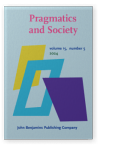Vol. 15:5 (2024) ► pp.779–799
Exploring lexical associations in English as a Lingua Franca interactions
Taking verbs of perception as an example
The current research draws on the pragmatic approach to ELF initiated by Kecskes (2019), who proposes that temporary norms and routines are created during intercultural encounters and interactions. Based on the qualitative and quantitative analysis of collocate tokens that are strongly associated with the verb phrases of see, look, hear, listen, watch, and feel, retrieved from Asian and European ELF corpora, this study demonstrates the tendency to use similar lexical associative patterns among ELF interlocutors despite their distinct linguacultural backgrounds. An analysis of the lexical associations of the verb phrases in ELF and English Native Language (ENL) corpora further confirms that ELF speakers do not conform to ENL conventions; instead, they start to develop their own norms that are characterized by specific lexical associations and formulaic expressions.
Article outline
- 1.Introduction
- 2.Literature review
- 3.Corpora and methodology
- 4.Corpus findings and discussion
- 4.1Comparing the lexical associations of Asian ELF interlocutors and ENL speakers
- 4.2Comparing the lexical associations of Asian and European ELF interlocutors
- 5.Conclusion
- Acknowledgements
- Notes
-
References
